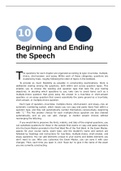Exam (elaborations)
Lucas11e_TB_Chapter10|Beginning and Ending the Speech
- Course
- COMM 110
- Institution
- Columbia College (CC )
Beginning and Ending the Speech he questions for each chapter are organized according to type: true-false, multiplechoice, short-answer, and essay. Within each of these categories, questions are Tclustered by topic, roughly following the order of topics in the textbook. To provide as much flexib...
[Show more]



